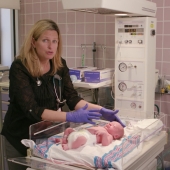Cesarean delivery — also known as a C-section — is a surgical procedure used to deliver a baby through incisions in the mother's abdomen and uterus. A C-section might be planned ahead of time. Often, however, the need for a first-time C-section doesn't become obvious until you are in labor. Sometimes a C-section is safer for you or your baby than is a vaginal delivery. Your doctor might recommend a C-section if:
- Your labor isn't progressing. When your cervix isn't opening enough despite strong contractions over several hours.
- Your baby isn't getting enough oxygen. For example when There's a problem with the umbilical cord.
- Your baby or babies are in an abnormal position.
- You're carrying multiples.
- There's a problem with your placenta. For example if the placenta covers the opening of your cervix (placenta previa)
- You have a health codition. complex heart problems, high blood pressure requiring urgent delivery or an infection that could be passed to your baby during vaginal delivery — such as genital herpes or HIV.
- Mechanical obstruction. You might need a C-section if you have a large fibroid obstructing the birth canal, a severely displaced pelvic fracture or your baby has a very large head.
- You've had a previous C-section. Depending on the type of uterine incision and other factors, it's often possible to attempt a vaginal birth after a previous C-section. In some cases, however, your doctor might recommend a repeat C-section.
Some women request C-sections with their first babies — to avoid labor or the possible complications of vaginal birth or to take advantage of the convenience of a planned delivery. However, this is discouraged if you plan on having several children.
Recovery from a C-section takes longer than does recovery from a vaginal birth. And like other types of major surgery, C-sections also carry risks to you and your baby.
Risks to your baby include:
- Breathing problems. C-sections done before 39 weeks of pregnancy or without proof of the baby's lung maturity might increase the risk of breathing problems for babies.
- Surgical injury. Although rare, accidental cuts to the baby's skin can occur during surgery.
- C-section babies have a slightly higher risk of developing obesity, asthma and other ailments than do children born vaginally. There are differences between the microbial communities on their skin and in their guts than babies born vaginally.
Risks to the mother include:
- Inflammation and infection of the endometrium (membrane lining the uterus). (endometritis) — can cause fever, foul-smelling vaginal discharge and uterine pain.
- It’s a dangerous condition that requires urgent medical help.
- Increased bleeding. You're likely to lose more blood with a C-section than with a vaginal birth.
- Reactions to anesthesia. Adverse reactions to any type of anesthesia are possible.
Blood clots. The risk of developing a blood clot inside a vein — especially in the legs or pelvic organs — is greater after a C-section than after a vaginal delivery. If a blood clot travels to your lungs (pulmonary embolism), the damage can be life-threatening.
- You will be given medications to prevent it at the hopistal. You can aslo help prevent clots by walking frequently soon after surgery.
- Wound infection. Infections are more common with C-sections compared to vaginal deliveries.
- Surgical injury. Although rare, surgical injuries to nearby organs — such as the bladder can occur during a C-section. If there is a surgical injury during your C-section additional surgery might be needed.
- Increased risks during future pregnancies. After a C-section, you face a higher risk of potentially serious complications in a subsequent pregnancy — including problems with the placenta — than you would after a vaginal delivery. The risk of uterine rupture, when the uterus tears open along the scar line from a prior C-section, is also higher if you attempt vaginal birth after C-section (VBAC).
- If your C-section is scheduled in advance, certain blood tests will provide information about your blood type and your level of hemoglobin. These details will be helpful to your health care team in the unlikely event that you need a blood transfusion during the C-section.
- If your C-section is planned before 39 weeks for a non-emergency reason, your baby's lung maturity might be tested before the C-section. This is done with amniocentesis — a procedure in which a sample of the amniotic fluid is removed from the uterus for testing. Maturity amniocentesis can offer assurance that the baby is ready for birth.
Even if you're planning a vaginal birth, it's important to prepare for the unexpected. Discuss the possibility of a C-section with your health care provider well before your due date. After a C-section, you'll need time to rest and recover. Consider recruiting help ahead of time for the weeks following the birth of your baby.
- 9408 views













